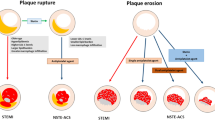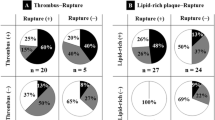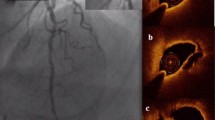Abstract
This study aimed to investigate the association of high-risk culprit plaque features by optical coherence tomography (OCT) with residual SYNTAX score (rSS) and the predictive value of rSS for major adverse cardiac events (MACE) in patients with ST segment elevation myocardial infarction (STEMI). We included 274 patients and divided them into 3 groups — rSS=0 (n=72), 0<rSS≤8 (n=134), and rSS>8 (n=68). There were significant differences in plaque characteristics among three groups (plaque rupture: 44.4% versus 59.0% versus 64.7%, lowest to highest rSS, p=0.040; OCT-defined high-risk plaques: 16.7% versus 23.9% versus 35.3%, lowest to highest rSS, p=0.036; calcification: 38.9% versus 52.5% versus 61.8%, lowest to highest rSS, p=0.024). During a mean follow-up of 2.2 years, MACE occurred in 47 (17.2%) patients; rSS >8 group had higher MACE risk compared to rSS=0 (HR: 2.68, 95%CI: 1.11–6.5, P=0.029). In conclusion, culprit plaque morphology was significantly correlated with rSS, and elevated rSS was associated with higher cardiovascular risk in STEMI patients. ClinicalTrials.gov: NCT03593928




Similar content being viewed by others
References
Farooq, V., Serruys, P. W., Bourantas, C. V., et al. (2013). Quantification of incomplete revascularization and its association with five-year mortality in the synergy between percutaneous coronary intervention with taxus and cardiac surgery (SYNTAX) trial validation of the residual SYNTAX score. Circulation, 128(2), 141–151.
Song, Y., Gao, Z., Tang, X., et al. (2017). Impact of residual SYNTAX score on clinical outcomes after incomplete revascularisation percutaneous coronary intervention: a large single-centre study. EuroIntervention, 13(10), 1185–1193.
Barthélémy, O., Rouanet, S., Brugier, D., et al. (2021). Predictive value of the residual SYNTAX score in patients with cardiogenic shock. Journal of the American College of Cardiology, 77(2), 144–155.
Fujino, A., Kadohira, T., Redfors, B., et al. (2019). Significant association among residual SYNTAX score, non-culprit major adverse cardiac events, and greyscale and virtual histology intravascular ultrasound findings: a substudy from the PROSPECT study. EuroIntervention, 14(16), 1676–1684.
Tearney, G. J., Regar, E., Akasaka, T., et al. (2012). Consensus standards for acquisition, measurement, and reporting of intravascular optical coherence tomography studies: a report from the International Working Group for Intravascular Optical Coherence Tomography Standardization and Validation. Journal of the American College of Cardiology, 59(12), 1058–1072.
Prati, F., Romagnoli, E., Gatto, L., et al. (2020). Relationship between coronary plaque morphology of the left anterior descending artery and 12 months clinical outcome: the CLIMA study. European Heart Journal, 41(3), 383–391.
Ibanez, B., James, S., Agewall, S., et al. (2018). 2017 ESC Guidelines for the management of acute myocardial infarction in patients presenting with ST-segment elevation: the Task Force for the management of acute myocardial infarction in patients presenting with ST-segment elevation of the European Society of Cardiology (ESC). European Heart Journal, 39(2), 119–177.
Généreux, P., Palmerini, T., Caixeta, A., et al. (2012). Quantification and impact of untreated coronary artery disease after percutaneous coronary intervention: the residual SYNTAX (Synergy Between PCI with Taxus and Cardiac Surgery) score. Journal of the American College of Cardiology, 59(24), 2165–2174.
Sianos, G., Morel, M. A., Kappetein, A. P., et al. (2005). The SYNTAX score: an angiographic tool grading the complexity of coronary artery disease. EuroIntervention, 1(2), 219–227.
Sheng, Z., Zhou, P., Liu, C., et al. (2019). Relationships of coronary culprit-plaque characteristics with duration of diabetes mellitus in acute myocardial infarction: an intravascular optical coherence tomography study. Cardiovascular Diabetology, 18(1), 136.
Tan, Y., Zhou, J., Liu, C., et al. (2020). Association between plasma trimethylamine N-oxide and neoatherosclerosis in patients with very late stent thrombosis. The Canadian Journal of Cardiology, 36(8), 1252–1260.
Zhou, J., Sheng, Z., Liu, C., et al. (2020). Association between admission hyperglycemia and culprit lesion characteristics in nondiabetic patients with acute myocardial infarction: an intravascular optical coherence tomography study. Journal Diabetes Research, 2020, 1763567.
Bryniarski, K. L., Walters, D. L., Kim, C. J., et al. (2017). SYNTAX score and pre- and poststent optical coherence tomography findings in the left anterior descending coronary artery in patients with stable angina pectoris. The American Journal of Cardiology, 120(6), 898–903.
Brugaletta, S., Magro, M., Simsek, C., et al. (2012). Plaque compositional Syntax score: combining angiography and lipid burden in coronary artery disease. JACC: Cardiovascular Imaging, 5(3 Suppl), S119–S121.
Saka, K., Hibi, K., Kozuma, K., et al. (2015). Relation between the SYNTAX score and culprit vessel vulnerability in non-ST-segment elevation acute coronary syndrome. JACC: Cardiovascular Imaging, 8(4), 496–498.
Kim, H. O., Kim, C. J., Kurihara, O., et al. (2019). Angiographic features of patients with coronary plaque erosion. International Journal of Cardiology, 288, 12–16.
Song L, Chen R Z, Zhao X X, et al (2021) Mean platelet volume/platelet count ratio and culprit plaque morphologies: an optical coherence tomography study in patients with ST segment elevation myocardial infarction. J Cardiovasc Transl Res.
Sheng, Z., Tan, Y., Liu, C., et al. (2019). Relation of circulating trimethylamine N-Oxide with coronary atherosclerotic burden in patients with ST-segment elevation myocardial infarction. The American Journal of Cardiology, 123(6), 894–898.
Tan, Y., Sheng, Z., Zhou, P., et al. (2019). Plasma trimethylamine N-oxide as a novel biomarker for plaque rupture in patients with ST-segment-elevation myocardial infarction. Circulation. Cardiovascular Interventions, 12(1), e007281.
Park, K. W., Kang, J., Kang, S. H., et al. (2014). The impact of residual coronary lesions on clinical outcomes after percutaneous coronary intervention: residual SYNTAX score after percutaneous coronary intervention in patients from the Efficacy of Xience/Promus versus Cypher in rEducing Late Loss after stENTing (EXCELLENT) registry. American Heart Journal, 167(3), 384–392.e385.
Garcia, S., Sandoval, Y., Roukoz, H., et al. (2013). Outcomes after complete versus incomplete revascularization of patients with multivessel coronary artery disease: a meta-analysis of 89,883 patients enrolled in randomized clinical trials and observational studies. Journal of the American College of Cardiology, 62(16), 1421–1431.
Elgendy, I. Y., Mahmoud, A. N., Kumbhani, D. J., et al. (2017). Complete or culprit-only revascularization for patients with multivessel coronary artery disease undergoing percutaneous coronary intervention: a pairwise and network meta-analysis of randomized trials. JACC. Cardiovascular Interventions, 10(4), 315–324.
Hwang, D., Kang, J., Yang, H. M., et al. (2019). Better prognosis after complete revascularization using contemporary coronary stents in patients with chronic kidney disease. Circulation. Cardiovascular Interventions, 12(8), e007907.
Jia, H., Abtahian, F., Aguirre, A. D., et al. (2013). In vivo diagnosis of plaque erosion and calcified nodule in patients with acute coronary syndrome by intravascular optical coherence tomography. Journal of the American College of Cardiology, 62(19), 1748–1758.
Vroegindewey, M. M., Schuurman, A. S., Kardys, I., et al. (2019). SYNTAX score in relation to intravascular ultrasound and near-infrared spectroscopy for the assessment of atherosclerotic burden in patients with coronary artery disease. EuroIntervention, 14(13), 1408–1415.
Acknowledgements
We gratefully acknowledge all individuals who participated in this study. We are grateful to the Department of Cardiology, Cardiovascular Institute of Fuwai Hospital, for its help in recruiting patients.
Funding
This study is supported by the Chinese Academy of Medical Sciences Innovation Fund for Medical Sciences (2016-I2M-1-009), National Natural Science Foundation of China (81970308), Shenzhen Key Medical Discipline Construction Fund (SZXK001) and the Fund of “Sanming” Project of Medicine in Shenzhen (SZSM201911017).
Author information
Authors and Affiliations
Corresponding author
Ethics declarations
Human Subjects/Informed Consent Statement
All procedures followed were in accordance with the ethical standards of the responsible committee on human experimentation (institutional and national) and with the Helsinki Declaration of 1975, as revised in 2000. The study was approved by the institutional ethics committee of Fuwai Hospital (No. 2017-866), and informed consent was obtained from all patients being included in the study.
Conflict of Interest
The authors declare no competing interests.
Additional information
Associate Editor Craig M. Stolen oversaw the review of this article
Publisher’s Note
Springer Nature remains neutral with regard to jurisdictional claims in published maps and institutional affiliations.
Supplementary Information
Supplementary Fig.1 Representative cross-sectional optical coherence tomography images. a Fibrous plaque identified as a homogeneous, highly backscattering region (asterisk). b Lipid-rich plaque identified as a low-signal region with a diffuse border (asterisk) and thin-cap fibroatheroma with fibrous cap thickness of 50 μm. c Plaque rupture identified by the discontinuous fibrous cap (arrow) and cavity formation (asterisk). d Plaque erosion identified by the presence of attached thrombus (arrow) overlying an intact plaque. e Calcification identified by the presence of a well-delineated, low-backscattering heterogeneous region (asterisk). f Micro-vessels recognized as low-signal, sharply delineated, tubule luminal structures (arrow). g Cholesterol crystal (arrow) identified by linear, highly backscattering structures without remarkable backward shadowing. h Macrophage infiltration (arrow) defined as a signal-rich, highly reflective, punctate region with backward shadowing. (Adapted from reference[10] with permission).
ESM 2
(DOCX 16 kb)
ESM 3
(DOCX 25 kb)
ESM 4
(DOCX 21 kb)
Rights and permissions
About this article
Cite this article
Wang, Y., Zhao, X., Zhou, P. et al. Residual SYNTAX Score in Relation to Coronary Culprit Plaque Characteristics and Cardiovascular Risk in ST Segment Elevation Myocardial Infarction: an Intravascular Optical Coherence Tomography Study. J. of Cardiovasc. Trans. Res. 15, 75–83 (2022). https://doi.org/10.1007/s12265-021-10152-6
Received:
Accepted:
Published:
Issue Date:
DOI: https://doi.org/10.1007/s12265-021-10152-6




